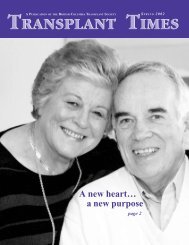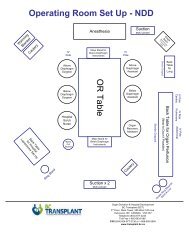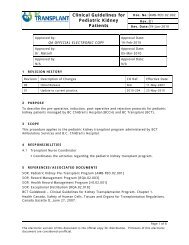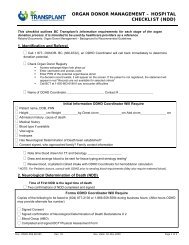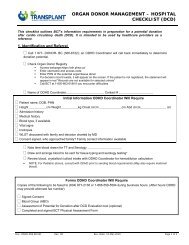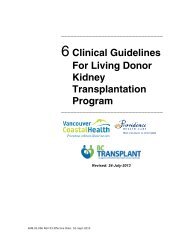4. Clinical Guidelines for Liver Transplantation (PDF) - British ...
4. Clinical Guidelines for Liver Transplantation (PDF) - British ...
4. Clinical Guidelines for Liver Transplantation (PDF) - British ...
You also want an ePaper? Increase the reach of your titles
YUMPU automatically turns print PDFs into web optimized ePapers that Google loves.
Guidebook <strong>for</strong> the Solid Organ Transplant Programme Chapter 4<br />
<strong>4.</strong>1.2 INDICATIONS AND REFERRAL GUIDELINES CONT.<br />
Hepatitis B: With the advent of effective strategies <strong>for</strong> preventing allograft reinfection with<br />
hepatitis B, patients with hepatitis B can now be considered <strong>for</strong> liver transplantation. The HBV<br />
DNA level must be at the lowest level possible in order to meet transplant criteria. Those who<br />
have high HBV-DNA levels will be treated with Lamivudine at 100 mg daily. This results in<br />
HBV-DNA becoming undetectable after approximately four to six weeks in about 90% of such<br />
patients. Patients who do not respond may be treated with Adefovir, Tenofovir or Entecavir.<br />
Those who remain HBV-DNA at a titer greater than 500,000 copies/mL cannot be activated <strong>for</strong><br />
transplantation. Patients with HBV who are identified, as possible transplant recipients should<br />
only be started on Lamivudine or Adefovir, after discussion with the transplant team. Although<br />
Lamivudine is well tolerated, there is a high rate of resistance by the development of mutant<br />
hepatitis B virus. This is approximately 50% per year <strong>for</strong> the first three years and the emergence<br />
of a mutant virus will render the patient HBV-DNA positive and makes transplantation more<br />
problematic as high-dose HBIG is then required to reduce the risk of allograft reinfection. Even<br />
HBV-DNA negative patients with hepatitis B are at risk of allograft reinfection. Fortunately,<br />
this can be prevented using a combination of antiviral drugs and immunoprophylaxis. We are<br />
currently using long-term prophylaxis with Lamivudine combined with low dose hepatitis B<br />
immune globulin (HBIG). Although patients can also develop HBV escape mutants that are<br />
resistant to the HBIG, at present the combination of Lamivudine and immune globulin appears<br />
to be very effective at preventing HBV recurrence.<br />
Alcoholic <strong>Liver</strong> Disease: Patients with liver failure due to or associated with alcohol abuse<br />
can be considered <strong>for</strong> transplantation provided that they have demonstrated full and sustained<br />
rehabilitation from alcohol and other substance abuse and that social supports and an abstinence<br />
maintenance program are in effect. The minimal criteria are at least 6 months verifiable<br />
abstinence, willingness to sign abstinence and monitoring contract, a satisfactory report from an<br />
independent alcohol and drug counsellor and favourable assessments from the transplant<br />
program staff members who have expertise in evaluation of patients with a history of substance<br />
abuse.<br />
Metabolic Diseases: <strong>Liver</strong> transplantation is occasionally offered as therapy <strong>for</strong> patients<br />
with genetic disorders that can be corrected by liver transplantation. Examples include familial<br />
amyloidosis, or metabolic conditions such as oxaluria, glycogen storage disease and urea cycle<br />
defects.<br />
Hepatocellular Carcinoma: Patients with hepatocellular carcinoma can be considered <strong>for</strong><br />
liver transplantation. However, they must be carefully selected to minimize the chance of<br />
recurrence of metastatic disease, because the progression of hepatoma is accelerated by<br />
immunosuppression. Patients with one lesion at 5 cm or up to 3 lesions, none greater than 3 cm.<br />
Patients with solitary tumors up to 6 cm could be considered if they showed a good response to<br />
pretransplant cytoreduction. All patients with single tumor should be offered pretransplant<br />
cytoreductive therapy. Smaller tumors will be treated with RFA or alcohol ablation and large<br />
ones with chemoembolization or combination therapy. Patients who have larger lesions are<br />
occasionally considered if they have a good response to chemoembolization. A “good response”<br />
is shrinkage of the tumour, with a needle biopsy of the area that is negative and a significant<br />
improvement in the alpha-fetoprotein. Chemoembolization is rarely used in patients who have a<br />
portal vein thrombosis or a previous shunt procedure.<br />
Chapter 4 – <strong>Clinical</strong> <strong>Guidelines</strong> <strong>for</strong> <strong>Liver</strong> <strong>Transplantation</strong> – July, 2010 Page 2<br />
See Page 1 <strong>for</strong> disclaimer



